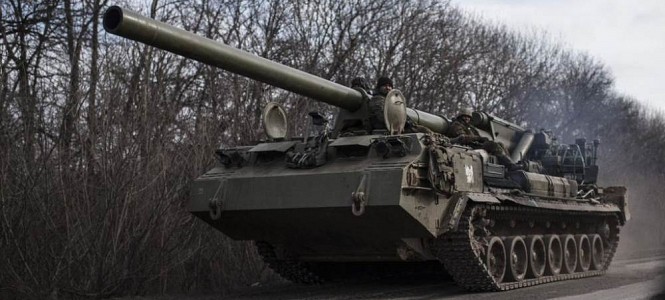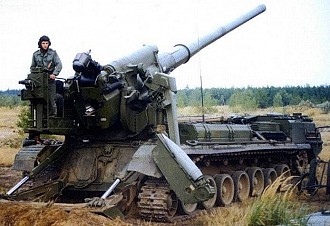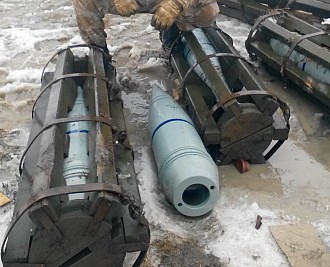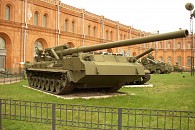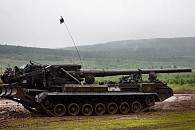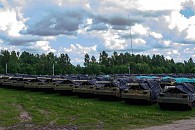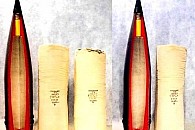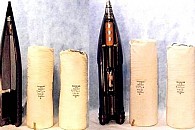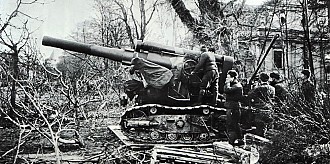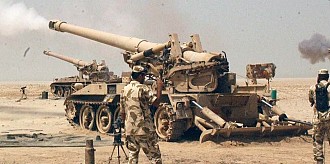Artillery / Self-propelled howitzers / 2S7 Pion
2S7 Pion
General Facts
- TYPE
Self-propelled howitzer - ORIGIN
 USSR
USSR - NICKNAMES
Pion, Peony (nickname)
M1975 (NATO designation)
Malka (Russian nickname)
SO-203 (official Russian designation) - DESIGNED
1967 - 1974 - DESIGNER
Kirov factory & Barrikady arsenal - PRODUCTION
1975 - 1985 (2S7)
1985 - 1990 (2S7M) - PRODUCERS
 USSR - Kirov factory
USSR - Kirov factory - QUANTITY
Over 1.000 produced, production complete. - UNIT COST
Unknown - CHARACTERISTICS
 Very long range for tube artillery
Very long range for tube artillery
 Fires very powerful shells
Fires very powerful shells
 Limited rate of fire
Limited rate of fire
 Crew is exposed in firing position
Crew is exposed in firing position
Introduction
The 2S7 is a late Cold War era self-propelled howitzer of Russian origin. In 1967 a requirement for a large caliber long range self-propelled howitzer was issued and in 1976 the first 2S7 were in active service. The 2S7 has the nickname Pion, which is peony in English. The 2S7 Pion is the most powerful mass produced self-propelled howitzer in existence.
Layout
The 2S7 is based on a highly modified and stretched T-80 chassis. Four crewmembers are seated in the front cabin, the engine is mounted behind it and three crew members are in the rear compartment. The ordnance is mounted at the rear. A giant spade at the rear is lowered to provide stability while firing.
Firepower
The 2S7 is fitted with the massive 56-caliber 203mm 2A44 howitzer. With standard ammunition it has a range of 37.4 km and a rocket-assisted projectile can be fired out to 47.5 km. The rate of fire is 1.5 rounds per minute. Four rounds of ammunition are carried on the 2S7 with the remainder on a support vehicle. The improved 2S7M carries 8 rounds and has a rate of fire of 2.5 rpm. No secondary armament is fitted.
Protection
The steel armor protects the crew against small arms fire and shell splinters when on the move. In the firing position the crew members are exposed since the ordnance is mounted in the open. An NBC system is fitted, but smoke grenade launchers are not.
Mobility
The 2S7 is based on a tracked chassis that provides a reasonably good cross country performance given its size and weight. The 780 hp V-46 diesel engine provides propulsion. Even with this amount of power the 2S7 remains a quite slow vehicle. The improved 2S7M uses the more reliable 840 hp V-84 diesel engine.
Users
The 2S7 Pion was used by many USSR nations. It is estimated that over 1.000 units have been built. Today the 2S7 is relatively uncommon as with the end of the Cold War the need for such a powerful weapon system has faded.
2S7 Pion
2S7: The 2S7 Pion is a massive tracked self-propelled howitzer. The chassis is based on the T-80 main battle tank. The 2S7 is fitted with a 203mm L/56 2A44 howitzer.
2S7M: The late production variant is designated 2S7M. It was designed under the Malka program. The 2S7M is fitted with a more powerful and reliable engine, is fitted with newer radios, carries 8 rounds of ammunition and has an increased rate of fire of 2.5 rounds per minute.
- Specifications:
- 2S7 Pion
- 2S7M Malka
| Type | Self-propelled howitzer |
|---|---|
| Crew | 7 (commander, driver, radio operator, gunner, 2 loaders) |
| Length | 13.12 m (overall) |
| Width | 3.38 m |
| Height | 3.0 m |
| Ground clearance | 0.4 m |
| Weight | 45.0 t combat load |
| Ground pressure | 0.80 kg/cm2 |
| Wheelbase | Tracked chassis, 7 roadwheels, drive sprocket front, idler rear |
| Turn radius | ? |
| Engine | V-46-I diesel, 780 hp at 2.000 rpm |
| Power ratio | 17.3 hp/t |
|---|---|
| Transmission | ? |
| Speed | 50 km/h on road |
| Fuel | ? |
| Range | 650 km on road |
| Wall | 0.7 m |
| Trench | 2.5 m |
| Gradient | 40% gradient, 20% slope |
| Fording | 1.2 m |
| Armor | Steel, up to 10 mm |
| NBC equipment | Yes |
| Night vision | Yes |
|---|---|
| Smoke | No |
| Remarks | R-123M radio |
| Armament | 203mm L/56 2A44 howitzer |
| Weapon1 | 203.2mm L/56.2 2A44 howitzer 4 rounds on vehicle 0 to +60 degrees elevation, powered -15 to +15 degrees traverse, powered, non-stabilized |
| Weapon2 | - |
| Weapon3 | - |
| Weapon4 | - |
| Weapon5 | - |
| Weapon6 | - |
| Type | Self-propelled howitzer |
|---|---|
| Crew | 6 (commander, driver, radio operator, gunner, loader) |
| Length | 13.12 m (overall) |
| Width | 3.38 m |
| Height | 3.0 m |
| Ground clearance | 0.4 m |
| Weight | 46.5 t combat load |
| Ground pressure | 0.83 kg/cm2 |
| Wheelbase | Tracked chassis, 7 roadwheels, drive sprocket front, idler rear |
| Turn radius | ? |
| Engine | V-84V diesel, 840 hp at 2.000 rpm |
| Power ratio | 18.1 hp/t |
|---|---|
| Transmission | ? |
| Speed | 50 km/h on road |
| Fuel | ? |
| Range | 650 km on road |
| Wall | 0.7 m |
| Trench | 2.5 m |
| Gradient | 40% gradient, 20% slope |
| Fording | 1.2 m |
| Armor | Steel, up to 10 mm |
| NBC equipment | Yes |
| Night vision | Yes |
|---|---|
| Smoke | No |
| Remarks | R-173 radio |
| Armament | 203mm L/56 2A44 howitzer |
| Weapon1 | 203.2mm L/56.2 2A44 howitzer 8 rounds on vehicle 0 to +60 degrees elevation, powered -15 to +15 degrees traverse, powered, non-stabilized |
| Weapon2 | - |
| Weapon3 | - |
| Weapon4 | - |
| Weapon5 | - |
| Weapon6 | - |
203mm Soviet artillery shells
3OF43: HE-Frag projectile used in 3VOF34 long range and 3VOF42 short range round.
3OF44: HE-Frag projectile used in 3VOF35 rocket assisted round.
3O14: Cluster munition shell used in 3VO15 long range and 3VO16 short range round.
3G3 Galyan: Concrete piercing shell used in 2VG11 round.
Kleshchevina: Nuclear shell.
- Specifications:
- 3OF43
- 3OF44
- 3O14
- 3G3 Galyan
| Category | Artillery round |
|---|---|
| Type | HE-Frag |
| Diameter | 203 mm |
| Length | ? |
| Weight | 110 kg |
| Charge | 43.2 kg in 3VOF34, 25 kg in 3VOF42 |
|---|---|
| Warhead | HE-Frag, 17.8 kg explosive |
| Fuze | ? |
| Effects | ? |
| Velocity | 960 m/s at muzzle for 3VOF34 |
| Range | 37.4 km in 3VOF34, 25.4 km in 3VOF42 |
|---|---|
| Accuracy | ? |
| Tracer | - |
| Remarks | - |
| Category | Artillery round |
|---|---|
| Type | HE-Frag |
| Diameter | 203 mm |
| Length | ? |
| Weight | 102 kg |
| Charge | 43.2 kg |
|---|---|
| Warhead | HE-Frag, 13.3 kg explosive |
| Fuze | ? |
| Effects | ? |
| Velocity | ? |
| Range | 47.5 km in 3VOF35 |
|---|---|
| Accuracy | ? |
| Tracer | - |
| Remarks | -50 to +50° Celsius operational temperature range |
| Category | Artillery round |
|---|---|
| Type | Cluster munition |
| Diameter | 203 mm |
| Length | ? |
| Weight | 110 kg |
| Charge | 43.2 kg in 3VO15, 25 kg in 3VO16 |
|---|---|
| Warhead | 24x 0.23 kg submunition |
| Fuze | ? |
| Effects | ? |
| Velocity | ? |
| Range | 30.4 km in 3VO15, 13 km in 3VO16 |
|---|---|
| Accuracy | ? |
| Tracer | - |
| Remarks | - |
| Category | Artillery round |
|---|---|
| Type | Concrete piercing |
| Diameter | 203 mm |
| Length | ? |
| Weight | Over 100 kg |
| Charge | ? |
|---|---|
| Warhead | ? |
| Fuze | ? |
| Effects | ? |
| Velocity | ? |
| Range | ? |
|---|---|
| Accuracy | ? |
| Tracer | - |
| Remarks | - |

